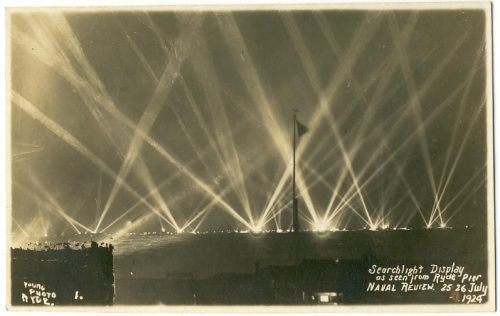Searchlight Experiments April 1898
During the last week the inhabitants of Ryde, especially those living near the Esplanade, have had the opportunity of witnessing a number of very interesting experiments with the search light, and the effect of the light flashing across the Solent and illuminating the houses of our town and the trees in its neighbourhood, was very fine.
The object of the experiments was to try and discover torpedo boats. Mines and forts may make Portsmouth impregnable, but no fleet is ever likely to attack a base of such magnitude or attempt the forlorn hope of getting in. What, on the other hand, is likely to occur is an attempt by torpedo boats to rush in in the hope of “bagging” a vessel in the harbour. In this port this has been successfully accomplished experimentally. The weak point in the searchlight cordon has been off Southsea Castle, where boats have slipped past unseen close to the shore.
The new installation is a light placed directly on the sea wall, only some ten feet or less above the water and in consequence able to illuminate a very large area of sea. The operations began a little after eight o’clock on Monday night, but were at first of a partial character. By nine, however, five lights were burning steadily, each covering its assigned area, forming a cordon of light through which no torpedo boat could pass undetected. The Castle light being placed so low, looked at a little distance more like a village fair shooting gallery than an implement of ultra scientific warfare.
The inhabitants had turned out in great force to look on and crowded round the projector, those pressing too near becoming illuminated and telling out as blots of light, their faces looking like Chinese lanterns. The human element was busy altogether, since every now and again the light being shifted suddenly projected huge shadows into the sky on a scale the Spectre of the Brocken can hardly surpass.
The searchlight experiments were repeated on Tuesday night, the dynamos having given trouble on Monday night and caused the experiment to be of a somewhat negative nature. Six torpedo boats and two destroyers under Commander Nicholson were told off to try and “rush” the passage, the idea being that the torpedo boats should manoeuvre to attract the lights and enable the destroyers to slip past unobserved, and again on the following day experiments were continued.
On Wednesday evening, a flotilla of second-class torpedo boats were directed to make a descent on the harbour from various directions. All the guns were manned in the forts ashore and at Spithead, and from half-past eight powerful searchlights completely illuminated the roadstead. Officers at various stations made observations, and on a torpedo-boat being seen the bugle-call to attention was sounded and passed on to all the batteries. Soon after 10 o’clock a torpedo-boat was observed dodging about well out to sea. Bugle-calls all round apprised everyone of her presence, and the guns were turned upon the little craft. On active warfare she would have been swept off the sea in a few seconds, for the rate of discharge of each of the quick-firing guns was about 24 rounds in a minute and a half. With smaller machine-guns the rate of firing was of course much quicker.
The operations were witnessed by General Davis and his staff, and some War Office officials. The night was very dark, with a drizzling rain. All the lights worked well with the exception of one on Southsea Beach.
Source: IW Observer April 1898
Image: Postcard – Searchlight Display, Naval Review July 1924
Article: Ann Barrett

